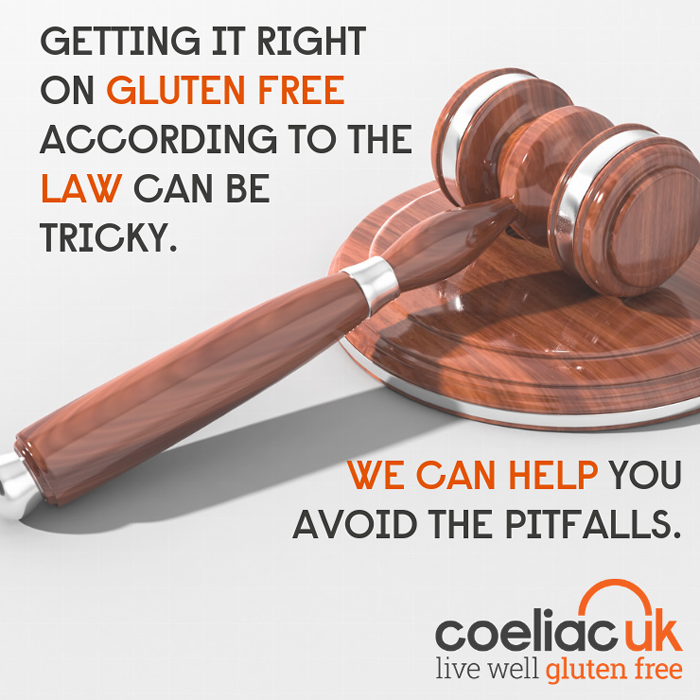Gluten free and the law
- The term gluten free is covered by European regulation (Regulation (EU) No 828/2014) and enshrined in UK law
- To label gluten free on your products you need to be sure that they contain 20 parts per million (ppm) or less of gluten
- It’s mandatory for food brands to provide information on packaging of the presence of the fourteen allergens, including gluten (wheat, barley, rye and oats), as deliberate ingredients within a product
- Download our Gluten Free Guidance or join our Crossed Grain Trademark product certification scheme and receive advice and support from our Food Policy team.

How we can help you
Making sure you can comply with the law is key for both your business and your customers. By working with us, we can help you tap into the gluten free market and help you increase your food revenue as seen by some of the other brands we work with.
With 88% of our members saying they look for gluten free and the Crossed Grain trademark on products, enquire about our Crossed Grain product certification scheme and get your company set up and ready for providing safe gluten free food with confidence using the leading European gluten free certification mark .
Communicating gluten free
To label gluten free on your products you need to be sure that they contain 20 parts per million (ppm) or less of gluten. The legislation on the labelling of gluten free foods, Regulation (EU) No 828/2014, covers the absence of gluten in food to meet the standard for gluten free and is a separate piece of legislation. The term can only be used for products that contain 20ppm or less of gluten and applies to all foods sold in catering establishments and pre-packaged products.
The term can be used on specialist substitute gluten free products like breads, flours and crackers, which may contain gluten-free (Codex) wheat starch, as well as processed foods that are naturally gluten free like soups, baked beans and crisps. The ‘gluten free’ label may also be used for uncontaminated oat products. For oat products labelled gluten free the oats themselves must also contain no more than 20ppm.
If you would like our help on communicating your gluten free options to customers or require further information around how to safely produce gluten free, then download our Gluten Free Guidance or join our Crossed Grain product certification scheme and receive advice and support from our Food Policy team.
Ingredients list
The Food Information Regulation for Consumers, Regulation (EU) No 1169/2011, introduced in 2014 makes it mandatory for food brands to provide information on packaging on the presence of the fourteen allergens including gluten (wheat, barley, rye and oats) as deliberate ingredients within products.
If a cereal containing gluten is used as a deliberate ingredient, it must be listed on the ingredients list, no matter how much is used. When labelling foods you must name the specific grain that has been used, for example, wheat, rye, barley, oats, spelt, khorasan wheat (commercially known as Kamut®), triticale or their hybridised strains.
Food Information Regulations requires that allergens must be emphasised in the ingredients list. This is a requirement of the which combines rules on food and nutrition labelling into a single EU regulation and covers:
- setting a minimum font size to make labelling clearer
- emphasising allergens in the ingredients list
- use of allergy advice boxes.
You can find a useful information booklet on the Food Standards Agency website: Allergy: what to consider when labelling food’. Technical guidance is also available on the Food Standards Agency website. There is also useful guidance from the Food and Drink Federation on labelling gluten free produced with advice from ourselves.
Exemptions
There are some ingredients which are made from a cereal containing gluten where the grain does not have to be listed. This is because processing has removed the gluten.
The European Commission has worked with the European Food Safety Authority (EFSA) to develop a list of ingredients which do not have to be labelled as being from a gluten containing grain.
The following ingredients are gluten free:
- glucose syrups derived from wheat or barley including dextrose
- wheat based maltodextrins
- distilled ingredients made from cereals that contain gluten e.g. alcoholic spirits.
Although these ingredients can be made from cereals containing gluten, you do not have to label them as such because the processing has removed the gluten.
‘May contain’ guidance
The Food Standards Agency has produced voluntary guidance on when to label a product with a ‘may contain’ statement. You can download this guidance from the Food Standards Agency website.
Examples of labelling terms include:
- may contain traces of gluten
- made on a line handling wheat
- made in factory also handling wheat.
Before using terms like these, manufacturers should assess the risk that the product could be contaminated with gluten. This allows the consumer to make an informed individual risk assessment and decide whether or not to include the product in their diet. Food Standards Agency best practice guidance does not recommend using a 'may contain' statement on products labelled gluten free. You can read the FSA guidance here.